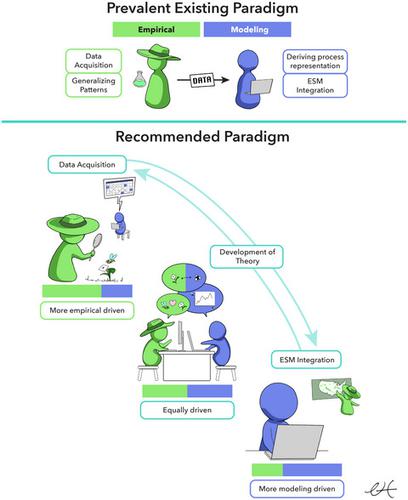当前位置:
X-MOL 学术
›
Glob. Change Biol.
›
论文详情
Our official English website, www.x-mol.net, welcomes your
feedback! (Note: you will need to create a separate account there.)
Increasing the spatial and temporal impact of ecological research: A roadmap for integrating a novel terrestrial process into an Earth system model
Global Change Biology ( IF 10.8 ) Pub Date : 2021-09-20 , DOI: 10.1111/gcb.15894 Emily Kyker-Snowman 1 , Danica L Lombardozzi 2 , Gordon B Bonan 2 , Susan J Cheng 3 , Jeffrey S Dukes 4, 5 , Serita D Frey 1 , Elin M Jacobs 4 , Risa McNellis 6 , Joshua M Rady 7 , Nicholas G Smith 6 , R Quinn Thomas 7 , William R Wieder 2, 8 , A Stuart Grandy 1
Global Change Biology ( IF 10.8 ) Pub Date : 2021-09-20 , DOI: 10.1111/gcb.15894 Emily Kyker-Snowman 1 , Danica L Lombardozzi 2 , Gordon B Bonan 2 , Susan J Cheng 3 , Jeffrey S Dukes 4, 5 , Serita D Frey 1 , Elin M Jacobs 4 , Risa McNellis 6 , Joshua M Rady 7 , Nicholas G Smith 6 , R Quinn Thomas 7 , William R Wieder 2, 8 , A Stuart Grandy 1
Affiliation

|
Terrestrial ecosystems regulate Earth's climate through water, energy, and biogeochemical transformations. Despite a key role in regulating the Earth system, terrestrial ecology has historically been underrepresented in the Earth system models (ESMs) that are used to understand and project global environmental change. Ecology and Earth system modeling must be integrated for scientists to fully comprehend the role of ecological systems in driving and responding to global change. Ecological insights can improve ESM realism and reduce process uncertainty, while ESMs offer ecologists an opportunity to broadly test ecological theory and increase the impact of their work by scaling concepts through time and space. Despite this mutualism, meaningfully integrating the two remains a persistent challenge, in part because of logistical obstacles in translating processes into mathematical formulas and identifying ways to integrate new theories and code into large, complex model structures. To help overcome this interdisciplinary challenge, we present a framework consisting of a series of interconnected stages for integrating a new ecological process or insight into an ESM. First, we highlight the multiple ways that ecological observations and modeling iteratively strengthen one another, dispelling the illusion that the ecologist's role ends with initial provision of data. Second, we show that many valuable insights, products, and theoretical developments are produced through sustained interdisciplinary collaborations between empiricists and modelers, regardless of eventual inclusion of a process in an ESM. Finally, we provide concrete actions and resources to facilitate learning and collaboration at every stage of data-model integration. This framework will create synergies that will transform our understanding of ecology within the Earth system, ultimately improving our understanding of global environmental change, and broadening the impact of ecological research.
中文翻译:

增加生态研究的时空影响:将新的陆地过程整合到地球系统模型中的路线图
陆地生态系统通过水、能源和生物地球化学转化来调节地球气候。尽管在调节地球系统方面发挥着关键作用,但陆地生态历来在用于理解和预测全球环境变化的地球系统模型 (ESM) 中的代表性不足。科学家必须将生态学和地球系统建模结合起来,才能充分理解生态系统在推动和应对全球变化方面的作用。生态学见解可以提高 ESM 的现实性并减少过程的不确定性,而 ESM 为生态学家提供了广泛测试生态学理论并通过在时间和空间上扩展概念来增加其工作影响的机会。尽管存在这种共生关系,但将两者有意义地整合仍然是一个持续的挑战,部分原因是在将过程转化为数学公式和确定将新理论和代码集成到大型复杂模型结构中的方法方面存在后勤障碍。为了帮助克服这一跨学科挑战,我们提出了一个由一系列相互关联的阶段组成的框架,用于将新的生态过程或洞察力整合到 ESM 中。首先,我们强调了生态观察和建模迭代相互加强的多种方式,消除了生态学家的角色以最初提供数据而告终的错觉。其次,我们表明,许多有价值的见解、产品和理论发展都是通过经验主义者和建模者之间持续的跨学科合作产生的,无论最终是否将过程包含在 ESM 中。最后,我们提供具体的行动和资源,以促进数据模型集成每个阶段的学习和协作。这个框架将产生协同效应,改变我们对地球系统内生态的理解,最终提高我们对全球环境变化的理解,并扩大生态研究的影响。
更新日期:2021-09-20
中文翻译:

增加生态研究的时空影响:将新的陆地过程整合到地球系统模型中的路线图
陆地生态系统通过水、能源和生物地球化学转化来调节地球气候。尽管在调节地球系统方面发挥着关键作用,但陆地生态历来在用于理解和预测全球环境变化的地球系统模型 (ESM) 中的代表性不足。科学家必须将生态学和地球系统建模结合起来,才能充分理解生态系统在推动和应对全球变化方面的作用。生态学见解可以提高 ESM 的现实性并减少过程的不确定性,而 ESM 为生态学家提供了广泛测试生态学理论并通过在时间和空间上扩展概念来增加其工作影响的机会。尽管存在这种共生关系,但将两者有意义地整合仍然是一个持续的挑战,部分原因是在将过程转化为数学公式和确定将新理论和代码集成到大型复杂模型结构中的方法方面存在后勤障碍。为了帮助克服这一跨学科挑战,我们提出了一个由一系列相互关联的阶段组成的框架,用于将新的生态过程或洞察力整合到 ESM 中。首先,我们强调了生态观察和建模迭代相互加强的多种方式,消除了生态学家的角色以最初提供数据而告终的错觉。其次,我们表明,许多有价值的见解、产品和理论发展都是通过经验主义者和建模者之间持续的跨学科合作产生的,无论最终是否将过程包含在 ESM 中。最后,我们提供具体的行动和资源,以促进数据模型集成每个阶段的学习和协作。这个框架将产生协同效应,改变我们对地球系统内生态的理解,最终提高我们对全球环境变化的理解,并扩大生态研究的影响。










































 京公网安备 11010802027423号
京公网安备 11010802027423号